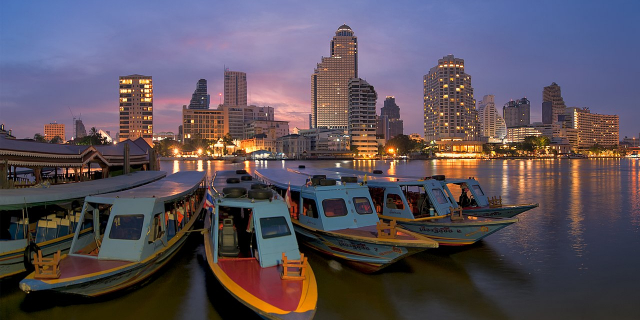Wat Arun Ratchawararam Ratchawaramahawihan (Thai: วัดอรุณราชวราราม ราชวรมหาวิหาร ) or Wat Arun (Thai pronunciation: [wát ʔarun], "Temple of Dawn") is a Buddhist temple (wat) in the Bangkok Yai district of Bangkok, Thailand. It is situated on Thonburi on the west bank of the Chao Phraya River. The temple derives its name from the Hindu god Aruṇa, often personified as the radiations of the rising sun. Wat Arun is among the best known of Thailand's landmarks. Although the temple has existed since at least the 17th century, its distinctive prang (spire) was built in the early 19th century during the reigns of Rama II and Rama III.
A Buddhist temple had existed at the site of Wat Arun since the time of the Ayutthaya Kingdom. It was then known as Wat Makok, after the village of Bang Makok in which it was built (makok is the Thai name for the Spondias pinnata plant). According to the historian Prince Damrong Rajanubhab, the temple was shown in French maps during the reign of Narai (1656–88). The temple was renamed Wat Chaeng by Taksin (1767–82) when he established his new capital of Thonburi near the temple, following the fall of Ayutthaya.[1] It is believed that Taksin vowed to restore the temple after passing it at dawn. The temple enshrined the Emerald Buddha image before it was transferred to Wat Phra Kaew on the river's eastern bank in 1785.[2] The temple was on the grounds of the royal palace during Taksin's reign, before his successor, Rama I (1782–1809), moved the palace to the other side of the river.[3] It was abandoned until the reign of Rama II (1809–24), who had the temple restored and had begun plans to raise the main pagoda to 70 m.[3] The work on the pagoda commenced during the reign of Rama III (1824–51). The main prang was completed in 1851, after nine years of continued construction.[4]
The temple underwent major restorations during the reign of Chulalongkorn (Rama V, 1868–1910) and in 1980, prior to the bicentenary celebration of Bangkok's foundation. The most extensive restoration work on the prang was undertaken from 2013 to 2017, during which a substantial number of broken tiles were replaced and lime plaster was used to re-finish many of the surfaces (replacing the cement used during earlier restorations). As the work neared its end in 2017, photographs of the results drew some criticism for the temple's new appearance, which seemed white-washed compared to its previous state. The Fine Arts Department defended the work, stating that it was carefully done to reflect the temple's original appearance.[5][6]





























Add new comment